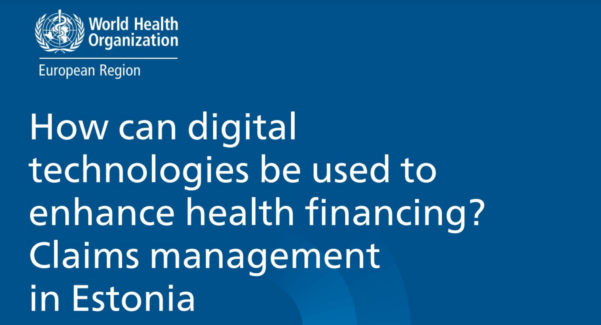Long-term economic forecasts by the Ministry of Finance suggest the revenues of the Health Insurance Fund of Estonia will grow by about 3.2% per year, but the expenses will have to increase by 5% per year in 2023–2040 to sustain the current level of access to care. Pille Banhard, member of the board of the Health Fund, calls for action towards sustainable financing through focus on efficiency and finding other solutions.
The Health Insurance Fund of Estonia, called “The Health Fund” (Tervisekassa), published a blog discussing the opinion of Pille Banhard, member of the board of the Health Insurance Fund on sustainable healthcare financing in Estonia .
The blog is available in Estonian language only and starts with alluding to the anticipation of a major deficit in healthcare by 2020, made ten years ago. Forecasts suggested that by year 2020, the Estonian Health Insurance Fund would experience a deep deficit and would use up all of its reserve funding. She describes how this disaster was avoided through a health financing reform implemented in 2017, that increased healthcare funding from public sources. Namely, if healthcare was previously financed only from the health insurance part of the social tax, the reform allowed for additional public funding to flow to the Health Insurance Fund for non-working pensioners. “Today, this is 12% of all our budget revenues”, says Ms Banhard in her blog.
Another increase in funding from public sources was due to the COVID-19 crisis. The economic forecasts made in 2020 beat the alarms about a potentially large deficit in health financing arising from a decrease in collected taxes. As a result, the government directed additional funds from the state budget to the Health Fund every year during 2021-2024. Nevertheless, these measures are not enough:
“Both the tax paid for non-working pensioners and the subsequent additional funding by the state have helped to keep the availability of healthcare services stable in recent years, but at the same time, it has not been sufficient to cover the medical needs of all Estonian people. At the moment, we can cover almost 95% of the optimal treatment needs, and people feel the shortfall in the form of treatment queues.”
She states the government’s expectation for the deficit in the Health Fund’s 2024 budget was more than 23 million euros. In the spring of 2024, however, the Ministry of Finance predicted more negative scenarios and lower level of collections for social taxes, suggesting the reveue shortage will be at 25 million euros. Despite this fact, the Health Fund will preserve the availability of services during 2024 by covering the deficit through the Fund’s undistributed income from previous years. But this trend raises deep concerns for future years:
“If in 2025 the Health Insurance Fund is missing nearly 150 million euros in the current state budget law, then in 2027 it will already rise to 251.6 million euros. However, these forecasts were prepared last year during the preparation of the state budget, and today, in the light of new economic forecasts, and also assessing the actual need for treatment, the deficit is significantly larger.”
Some of the mentioned driving factors behind this trend were the aging of the population, the increase in chronic diseases, rising costs of healthcare services, changes in the labor market, the aging of the working-age population. The author adds that Estonia invests only 7.1% of GDP in healthcare, which is “considerably lower than the European Union average of 9.9%”, which is also a strong factor. Moreover, expansion of the benefits package managed by the single payer also playes a role:
“In addition, new obligations have been added to the budget of the Health Fund, and healthcare services have become more expensive due to both new health technologies and salary increases for healthcare workers. Services that were previously financed directly from the state budget (such as emergency care, financing of residency, medicine warehouse, emergency assistance for uninsured persons, vaccination, prison medicine, etc.), which have been added to the budget of the Health Fund without sufficient funding, make up a third of our budget deficit, i.e. 50-60 million euros.”
Pille Banhard then recaps the current volume of services covered by the Fund and how detrimental for access and coverage would the rationing of care be if the deficit was not covered by additional funding:
“Last year, 1.19 million people used healthcare services in Estonia. Of these, nearly 785 thousand people used specialist medical care and 1.08 people used family medical care. However, if the Health Fund were to reduce the budget for specialist care by, for example, 10 million, this means that nearly 10,000 people will not receive the necessary treatment.
We have estimated, based on the long-term economic forecast of the Ministry of Finance, that the revenues of the Health Fund’s budget will grow by an average of 3.2% per year in the period 2023–2040 (revenues), but an increase of 5% per year in financial resources (expenses) is necessary to ensure the availability of healthcare services to date. Funding, which is mainly based on social tax, is no longer enough to maintain the healthcare system at the same level and provide the population with the necessary healthcare services.
The author then raises the main question of her blog by raising the sustainability issue:
“If we can’t find additional funds for health care together, then according to the current forecasts, we will either have to aggressively work on the reserves of the Health Fund or reduce the volume of contracts with health care providers. And in the worst case, you have to do both. Neither is a good option, because if the reserve is used, the Health Insurance Fund will run out of money in a couple of years, and in the other case, the availability of medical care will suffer – that is, people will have to wait longer and receive fewer medical services.”
In case if no additional health financing is provided, then as soon as in 2025, the Health Fund will have to buy less medical services than now by almost 9%, and risk postponing up to 40% of planned surgeries and not providing every tenth outpatient appointment.
The board member calls to look for efficiency and new solutions “in the system itself”. She illustrates how the implementation of digital solutions in Estonia (for example, the Health Portal, digital service platforms for family doctors, e-ambulance, etc.) are helping to maximize the working time of healthcare workers, which creates opportunities to serve a larger number of patients. In addition, with the decisions already made, the Health Fund will be able to deliver about 1% of the budget, or 21 million euros, more efficiently in 2025, concluded Pille Banhard.







